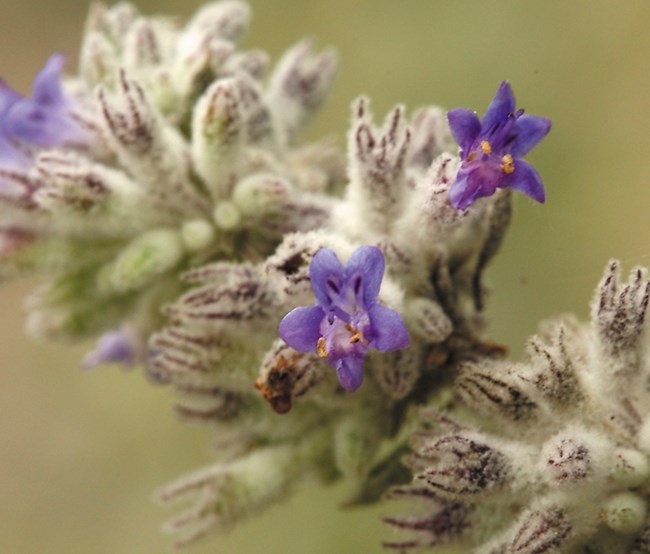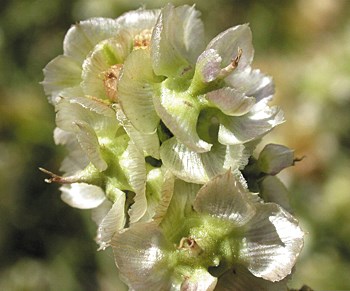
NPS / Brad Sutton
Approximately 12 miles (20 km) south of the park’s north entrance is the 0.25 mile (0.4 km) Cholla Cactus Garden Nature Trail; this flat loop leads hikers through nearly 10 acres (4 hectares) of landscape dominated by the teddybear cholla. This unusual stand of cacti is located in the Pinto Basin, a large expanse of alluvial fans covered with creosote bush (Larrea tridentata) and burrobush (Ambrosia dumosa) for as far as the eye can see. There are very few teddybear cholla stands in the park.

Hedgehog CactusEchinocereus engelmanniiMay–June One of our more common cacti, this species grows in clumps of erect cylindrical stems. The brilliant magenta flowers, along with the dense clusters of calico-colored spines, make it easy to identify in springtime. The hedgehog cactus relies heavily on bees for pollination. The flowers avoid self-pollinating by only opening the stigma lobes (female reproductive parts) after the bees have carried the pollen away. This is called protandry. 
BrittlebushEncelia farinosaJanuary–July This drought-deciduous shrub is common in open rocky habitats below 3,300 feet (1,000 m). Brittlebush can dominate the most exposed and hottest of slopes. The leaves appear blue-green to white due to a dense covering of hairs. You can spot brittlebush best when it blooms: the flowering stalk is branched and contains multiple large flowering heads, making it a very conspicuous part of the landscape. The stems on this woody shrub exude a bitter but fragrant resin, which helps protect it from hungry herbivores. 
Steve Matson Desert LavenderHyptis emoryiJanuary–May A shrub-like tree, desert lavender reach heights of 9 feet (2.8 m). You will find it along rocky canyons and washes in the warmer regions of the park, as it is sensitive to frost. Its leaves have an agreeable minty odor, which can be especially noticeable after rain. When it blooms, the nectar-rich flowers attract many native bees. 
Beavertail CactusOpuntia basilarisMarch–June This cactus has flat, blue-gray, spineless pads that appear fuzzy and soft, tempting people to make the mistake of touching them. Beware! The beavertail cactus is armed with many small bristles known as glochids, which are painful and very difficult to remove. The species name basilaris means “regal,” referring to the plant’s beauty when covered with large, nearly-neon pink flowers. Ants can often be found swarming the newly formed pads and flowers due to the copious amounts of nectar they produce. Native Americans traditionally used beavertail cactus for both food and medicine. 
James Andre Desert StarvineBrandegea bigeloviiMarch–May A native member of the cucumber family, this scrambling vine climbs over and around shrubs and other vegetation, particularly along washes where the deep taproot can access seasonal water. You can see the small, fragrant white flowers emerge after rains in the spring or summer. The plant climbs using unbranched tendrils; the green leaves have long finger-like lobes and white oil glands dotting the upper surface. The fruit is dry and prickly. 
Teddybear ChollaCylindropuntia bigeloviiMarch–May You can easily recognize teddybear cholla—the star of the Cholla Cactus Garden—by its densely interlaced yellow spines, tightly clustered stems, and dark lower trunk. Interestingly, the seeds from this plant are usually infertile. Teddybear cholla reproduces vegetatively, meaning that new plants start from fallen stem-joints. It is possible that this entire “garden” consists of only one individual! A word of advice: do not attempt to pet this teddybear. The stem-joints can easily detach and hitch a ride due to the miniscule barbs on the spines, giving it the nickname “jumping cholla.” Once they’ve latched on, the spines are very painful to remove. 
White RatanyKrameria bicolorApril–May Members of the genus Krameria are low-growing, densely-branched shrubs that parasitize the roots of neighboring woody plants. The striking flowers take an unusual form. The showy structures, which you might mistake for petals, are in fact bright magenta sepals bent backwards. The petals are highly modified: two of them act as oil glands and are only conspicuous if you are a bee. Bees combine this oil with pollen and feed it to their larvae. The best way to distinguish this species from the little-leaf ratany is to look at the barbs on the fruit: in white ratany, the barbs are all at the top in an umbrella-like whorl. 
Desert SennaSenna armataApril–May Senna is a diverse genus of tropical and subtropical shrubs, but this species has adapted to the desert. Leafless for much of the year, it has thickened cell walls, helping to prevent water loss. It doesn’t look like much until it goes into bloom, when it becomes a riot of yellow blossoms. Look for the delicate yellow wings of the cloudless sulfur butterfly as it visits this plant. 
Pencil ChollaCylindropuntia ramosissimaApril–August The narrow stems of this species offer a clue as to why it is referred to as the pencil cholla. These slender, multi-branched stems are diagnostic of this species, as suggested by the Latin name, ramosissima, which means “very much branched.” This cactus usually has very long spines emerging perpendicular to the stem, but some plants have no spines at all. A closer look at the stem reveals many diamond-shaped tubercles that appear to be etched into the stem, a unique trait among chollas. To see the beautiful orange or pink flowers of this species, look for them in the late afternoon of the hotter months (May–July). 
TrixisTrixis californicaJanuary–August This woody shrub’s dark green glandular leaves make it conspicuous on the landscape even when not in flower. When it blooms, trixis puts on a show with its bright yellow flowering heads. You’re most likely to see the blossoms in spring, but flowers are possible at other times of year if there has been adequate rainfall. Generally a low growing shrub, trixis thrives in shady canyons, where it can grow to be much larger than the specimen along this trail. Native Americans used this species as a tobacco substitute. 
Steve Matson Narrow-leaf Forget-me-notCryptantha angustifoliaJanuary–June This is a small annual herb with bristly hairs and small white flowers. The genus name Cryptantha means “hidden flower” in Greek. Like most members of this genus, this species will be hard for you to identify based on flowers alone. Instead, the most useful diagnostic characters rely heavily on the nutlets (seeds). You may see harvester ants collecting the small black nutlets; the ants likely act as seed dispersers for this plant. 
Schott's Indigo BushPsorothamnus schottiiMarch–May The deep indigo blue flowers of this intricately branched shrub are typical of many members of the pea or legume family (Fabaceae). They are zygomorphic (i.e., having one plane of symmetry) and have adapted specialized floral structures to promote bee pollination. Like other members of this family, the fruit is a legume (pod), in this case with a single seed. If you look closely at the pod you’ll see many red glands, from which a yellow-orange pigment can be used to dye baskets or clothing. 
Creosote BushLarrea tridentataApril–May Perhaps the most widespread perennial of the North American deserts (except the Great Basin Desert) is the creosote bush. This evergreen species is best known for its ability to grow into ancient clonal rings (over 10,000 years old), making it one of the longest living organisms on earth! Loaded with heavy oils and toxic alkaloids, creosote bush is well protected against herbivores and aridity. However, many gall-forming insects have adapted to its toxins, and some animals, such as the desert iguana (Dipsosaurus dorsalis), consume less toxic tissues like the flower petals. 
James Andre Hairy MilkweedFunastrum hirtellumApril–July This vine is a member of the Apocynaceae, or milkweed family. Generally, milkweeds are highly toxic. One insect that has evolved to take advantage of this is the striated queen butterfly, a relative of the monarch, which uses the hairy milkweed as a host for its larva. Caterpillars sequester these toxins in their bodies, making both them and their adult butterfly forms unpalatable to potential predators. 
GroundcherryPhysalis crassifoliaMarch–May This plant gets its name from the inflated calyx, which encapsulates the fruit in a papery husk akin to a Chinese lantern. The genus name Physalis means “bladder” in Greek, and refers to this papery calyx. This species is a close relative of the tomatillo often used for green salsa, but you should take care with plants in this family. Groundcherry is a member of the nightshade family, a group of plants known for being both the most toxic and the most edible family throughout the world. 
CheesebushAmbrosia salsolaFebruary–June Cheesebush is a short-lived pioneer species, often a dominant member of sandy washes and benches throughout the park. This plant does not stand out for any reason other than its abundance in disturbed areas. A member of the ragweed genus, it reproduces abundantly and quickly, with seeds that spread easily by wind and germinate soon after wetting. The common name derives from the smell emitted by the leaves when damaged: some people think that the crushed leaves smell like cheese. 
JojobaSimmondsia chinensisMarch–May A characteristic member of the Sonoran Desert flora, jojoba may be familiar to you as ingredient in moisturizing lotions or hair care products. The oil from the seeds is highly resistant to going rancid and is stable at high temperatures, making it a very high quality lubricant. Because of jojoba’s many uses and drought tolerance, it is now widely cultivated. It is ecologically important throughout the lower elevations; many animals consume its seeds and foliage. |
An official website of the United States government
Here's how you know
Official websites use .gov
A
.gov website belongs to an official government
organization in the United States.
Secure .gov websites use HTTPS
A
lock (
) or https:// means you've safely connected to
the .gov website. Share sensitive information only on official,
secure websites.
